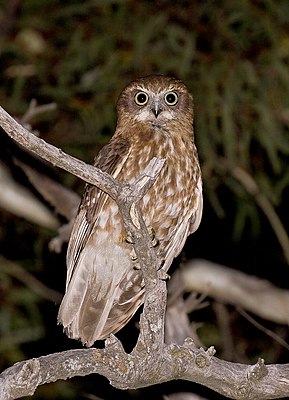Boobook Owl
| Boobook Owl | ||||||||||
|---|---|---|---|---|---|---|---|---|---|---|

Boobook Owl ( Ninox boobook ) |
||||||||||
| Systematics | ||||||||||
|
||||||||||
| Scientific name | ||||||||||
| Ninox boobook | ||||||||||
| ( Latham , 1801) |
The Boobookkauz ( Ninox boobook ) is an owl from the genus of Buschkäuze . He inhabits Australia and neighboring Southeast Asia .
description
The length is 25 to 36 centimeters with a weight of 146 to 360 grams, with the female about 65 grams heavier than the male. In warm areas the birds are generally smaller. The plumage is very variable with lighter desert and dark forest forms. The upper side is light to dark brown with irregular light or white spots on the elytra and an indistinct whitish shoulder band. The hand and arm wings are banded reddish brown and dark brown. The throat is white, the rest of the underside whitish with a broad red-brown stripe and transverse bands. The eyes are light greenish yellow, the beak is bluish gray. The feathered legs are brownish gray, the horn-colored claws have a dark tip.
Way of life
The adaptable species inhabits forests, orchards, parks and avenues, even in suburbs. It is absent in the tropical rainforest . Although it mostly occurs in lower regions, on Timor it rises to an altitude of 2300 meters. The owl can be found in the cloud forests on Mount Foho Taroman ( 1730 m ). Its food is mainly made up of insects and other arthropods , only during the breeding season it also preyes on small birds and mice. Most of the time it hunts from the hide, but it also catches insects during hunting flights.
voice
The boobook owl got its onomatopoeic species name from the short, two-tone double call buu-buuk , in which the second tone is lower than the first. Each tone is 0.25 seconds long with a half-second pause. The double call repeats about twenty times in a minute or two.
distribution
The boobook owl is numerous in most of Australia as well as in the east of the Lesser Sunda Islands and in southern New Guinea . The form-rich species is the most common owl in Australia.
Geographical differences
The nominate form N. b. boobook lives in South Australia , Queensland and Victoria . In the tropical north, west and south of Australia, as well as on Sawu, there is the lighter, sandy-brown N. b with yellow-brown stripes below . ocellata before. N. b. rotensis on Roti is smaller and has a different reputation. N. b. fusca in Timor, Romang and Leti is dark gray-brown above and heavily spotted below. N. b. plesseni on Alor is small in color , similar in color to fusca and marked with white and light brown spots all over the top. N. b. moae on moa is darker than ocellata . N. b. cinnamomina on the Topa and Babar Islands is deeply cinnamon brown at the top and strongly cinnamon brown at the bottom. N. b. remigialis on the Kei Islands is similar to moae , but is less clearly banded on the wings. N. b. pusillae in the lowlands of southern New Guinea is reminiscent of ocellata , but is significantly smaller.
literature
- Heimo Mikkola: Handbook owls of the world. All 249 species in 750 color photos. Original title: Owls of the World. A photographic guide. 2012, German-language edition, Franckh-Kosmos Verlags-GmbH & Co.KG, Stuttgart 2013, ISBN 978-3-440-13275-3 , p. 447.
Individual evidence
- ↑ Colin Trainor: Three million yr old + Sky Islands and Cloud Forests in Timor-Leste - First biological exploration of Mt Taroman (1,730 m) a small range in the south-west , accessed on October 30, 2015.
